Abstract
Purpose
Pedicle subtraction osteotomy (PSO) was developed to achieve significant correction of a deformity. It was initially used to correct sagittal plane deformities associated with ankylosing spondylitis, but recently it has also been performed in patients with post-traumatic kyphosis. Our aim was to report a case of a floating spine after PSO for post-traumatic kyphosis.
Methods
A 50-year-old man was injured after a fall. He had a compression fracture at T12 and an open fracture of the right lower limb. Although he presented with focal back pain, his open fracture was treated first by surgical intervention. The T12 compression fracture was treated conservatively. One year later, he had lower limb numbness and muscle weakness. His imaging demonstrated focal kyphosis on T12 and spinal cord compression. The diagnosis was post-traumatic kyphosis, which was treated with PSO. We performed osteotomy at T12, discectomy and bone graft at T11–T12, and posterior fusion from T10 to L2.
Results
One year after PSO, we removed the instruments because he complained of pain around them and found complete bony union between T11 and T12. He immediately experienced worse pain and could not walk or stand for more than 10 min. Imaging showed a floating spine between T12 and L1. He underwent anterior fusion at T12–L1, after which his severe back pain disappeared.
Conclusions
This case points out a pitfall of PSO. Although it is a powerful tool for correcting an imbalanced spine, we should recognize its pitfalls and try to avoid them.
Source : European Spine Journal , April 2014 Via Springer

No comments:
Post a Comment